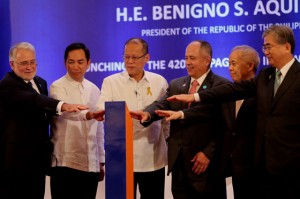President Benigno Aquino 3rd on Thursday said he will ask Congress to grant his government additional powers to fully address the expected energy deficiency next year.
“To be more efficient and impactful in our efforts, very soon, we will formally ask Congress for a joint resolution, that will authorize the national government to contract an additional generating capacity to address the 300-megawatt projected deficit, and, on top of that, to have sufficient regulating reserves equivalent to four percent of peak demand, for another 300 megawatts,” Aquino said in his speech during the launch of the Pagbilao 3 power plant project.
He, however, gave assurances that the government will not distort the power sector market.
“Let me assure our partners from the private sector [that] government intervention will be focused solely on addressing the projected shortage. We have no plans of intervening to distort the market or complicate the situation even further,” Aquino said.
The law prohibits contracting for additional power, unless the President declares there is a power crisis.
In July, Energy Secretary Jericho Petilla endorsed what he said was the best and fastest way for the government to address the looming power crisis: Aquino’s declaration of an energy emergency and invocation of his powers under the Electric Power Industry Reform Act (Epira) of 2001.
The President said the Department of Energy (DOE) has also rolled out an Interruptible Load Program (ILP), which gives incentives to certain customers who disconnect from the grid to use their generators.
Aquino explained that even with 1,799.52 megawatts from new and
recommissioned plants added to the supply, resulting in a total dependable capacity of 15,466 megawatts, the country faces the problem of outages during peak months.
“Forced power plant outages have been observed to rise especially in the summer months, coinciding with the periods of peak demand. This situation results in quite thin reserves, particularly in Luzon,” he said.
Other factors, the President noted, affect the performance of power plants, including weather, delays in construction and legal challenges.
“On top of this, part of our current supply comes from plants running beyond their maximum age, for instance, Agus 6 in Mindanao, which was originally designed to have only a 30-year lifespan, has now been running for more than twice as long,” he said.
There is an expected shortage of about 300 megawatts next summer that could lead to rotating brownouts for 20 days.
The President said this deficiency could reach 1,000 megawatts.
He, however, assured the public that the government has been closely monitoring the situation and that it “cannot be complacent.”
“After all, should there be a shortage, it is our people who will bear the brunt of the burden, and no amount of excuses or explanations will be able to temper the anger of the public,” Aquino said.
Petilla said Congress can define the terms and conditions of the additional powers it will grant the President.
“We are not asking for a blanket authority. We’ll come up with a circular, which will be a part of our recommendation on your resolution, which states that these government-contracted capacities will only be on standby. It cannot run until there is a yellow alert,” he added.
Moreover, the Energy chief clarified that Congress has the authority to curtail the government’s action in contracting power-generating capacities, and that these state-purchased power sources will not compete with the private sector.
Under the law, the government cannot intervene in power generation.


